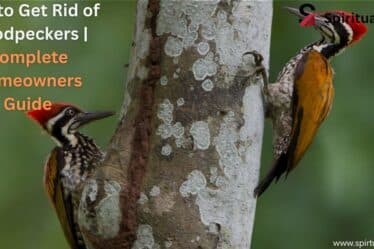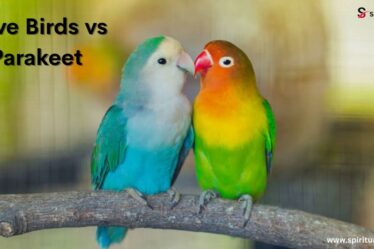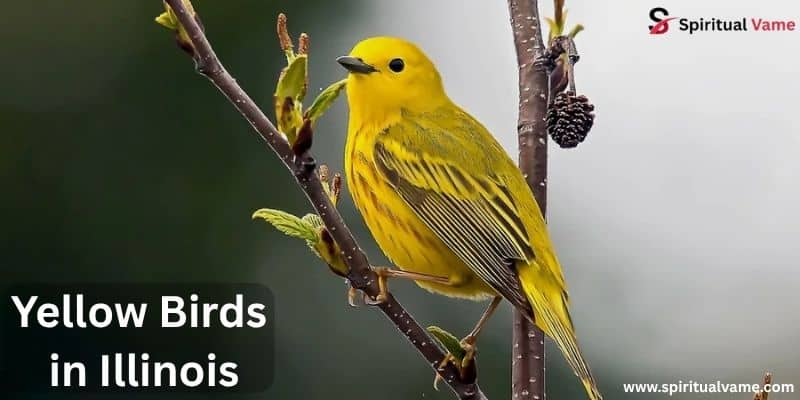
Illinois is a great place to see many bright and beautiful birds. One group that stands out is the yellow birds in Illinois. These birds are easy to spot because of their bold yellow feathers. They can be found in parks, forests, and even backyards. Whether you’re new to birdwatching or a long-time fan, yellow birds in Illinois will catch your eye and spark your interest.
This article focuses on the most common yellow birds in Illinois. You’ll learn how to identify them, where they live, and what makes them special. Get ready to enjoy the colorful world of these sunny birds flying across Illinois skies.
1. American Goldfinch
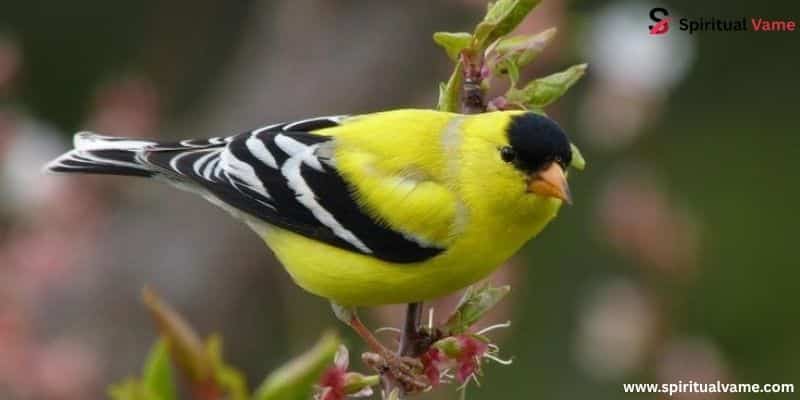
The American Goldfinch is perhaps the most common and beloved yellow bird in Illinois. Males are bright yellow with black wings during the breeding season, while females are duller in comparison. These small passerine birds are easy to attract to feeders, especially if you offer sunflower or nyjer seeds. They are often seen fluttering through meadows, gardens, and roadsides.
Goldfinches are late nesters, waiting until mid-summer when thistle seeds are abundant. They are highly social and often travel in flocks. With their sweet “per-chick-o-ree” call, they bring life and color to the warm months in Illinois.
2. Common Yellowthroat
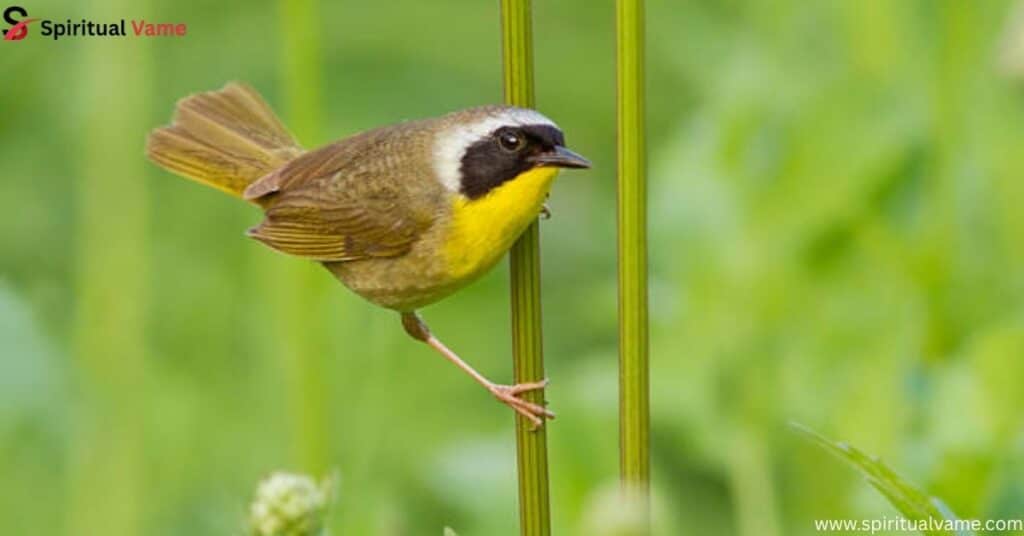
The Common Yellowthroat is a small warbler with a distinctive black mask across the male’s face. It has a bright yellow throat and underparts. Females lack the black mask but are just as charming. These birds prefer wet, shrubby habitats like marshes and moist meadows.
They are known for their “witchety-witchety-witchety” song and are often heard before they are seen. Despite their small size, they are aggressive in defending their territory. These insect-eating birds play an essential role in their ecosystem by helping control populations of small invertebrates.
3. Yellow-rumped Warbler
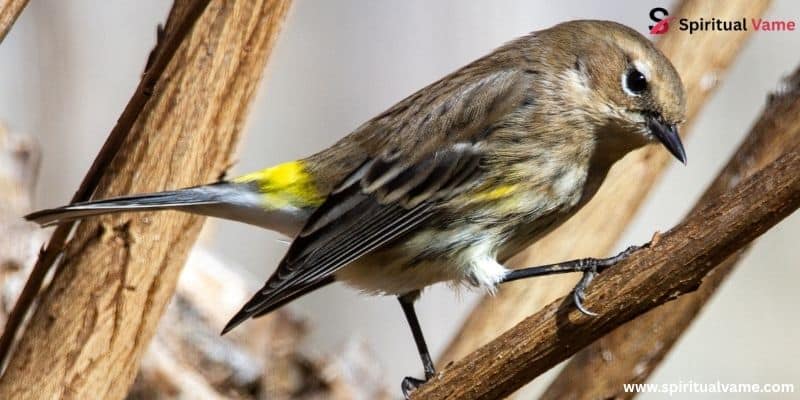
The Yellow-rumped Warbler stands out because of the bright yellow patches on its rump, sides, and crown. It is one of the most widespread warblers in North America and is often seen in Illinois during spring and fall migration. They adapt to a wide range of habitats, including forests, parks, and suburban areas.
Unlike many other warblers, Yellow-rumped Warblers can digest waxy berries, which allows them to survive colder temperatures and extend their range. They feed on insects during the warmer months and switch to fruit during winter.
4. Cedar Waxwing
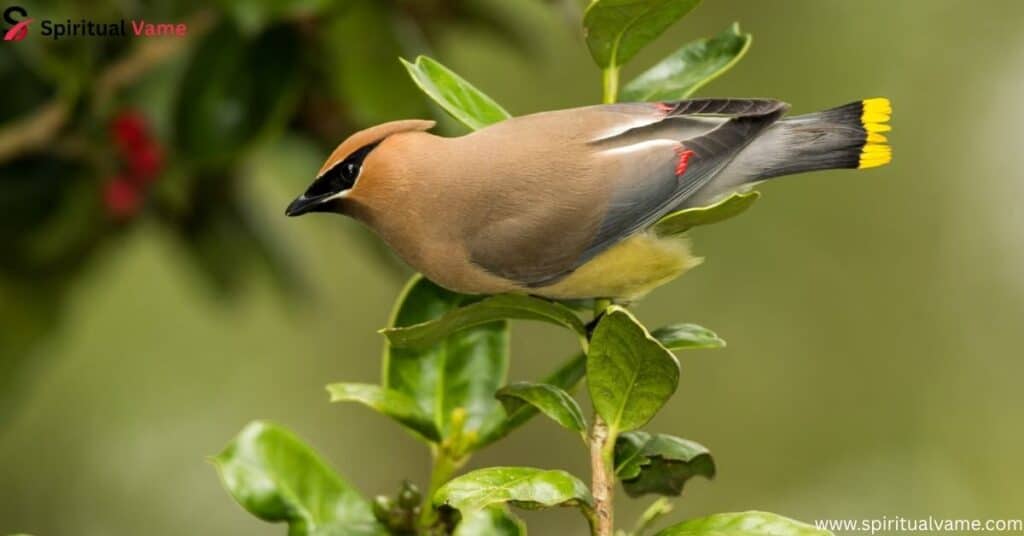
Though not entirely yellow, the Cedar Waxwing has a pale yellow belly that blends beautifully with its smooth brown head and black mask. These birds have a unique, silky appearance and love to gather in flocks, especially where fruiting trees are available. They are commonly seen in woodlands, orchards, and suburban neighborhoods across Illinois.
Cedar Waxwings are very social and often pass berries from one to another before eating. They are also one of the few North American birds that can survive mostly on fruit for extended periods, making them important for seed dispersal.
5. Baltimore Oriole Female
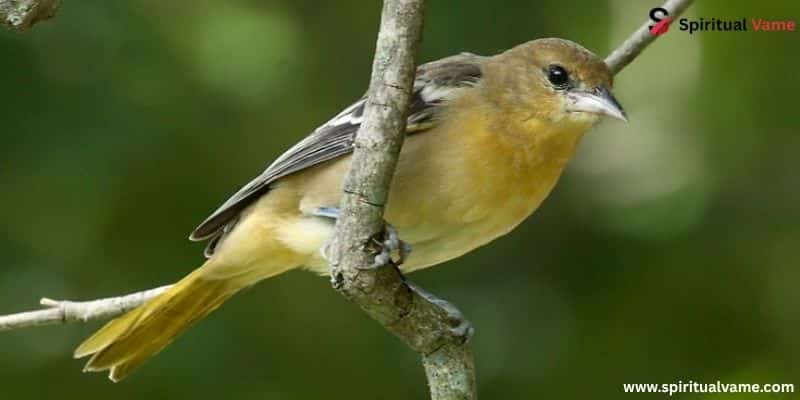
The female Baltimore Oriole is more yellowish-orange compared to the fiery orange male. You can spot them in the tree canopies of Illinois woodlands, often near rivers and streams. They are known for their hanging, pouch-like nests woven from grass and other plant fibers.
Baltimore Orioles are attracted to fruit and nectar, making them frequent visitors to feeders that offer orange slices or sugar water. Their rich, whistling songs add joy to spring and summer mornings throughout Illinois.
6. Eastern Meadowlark
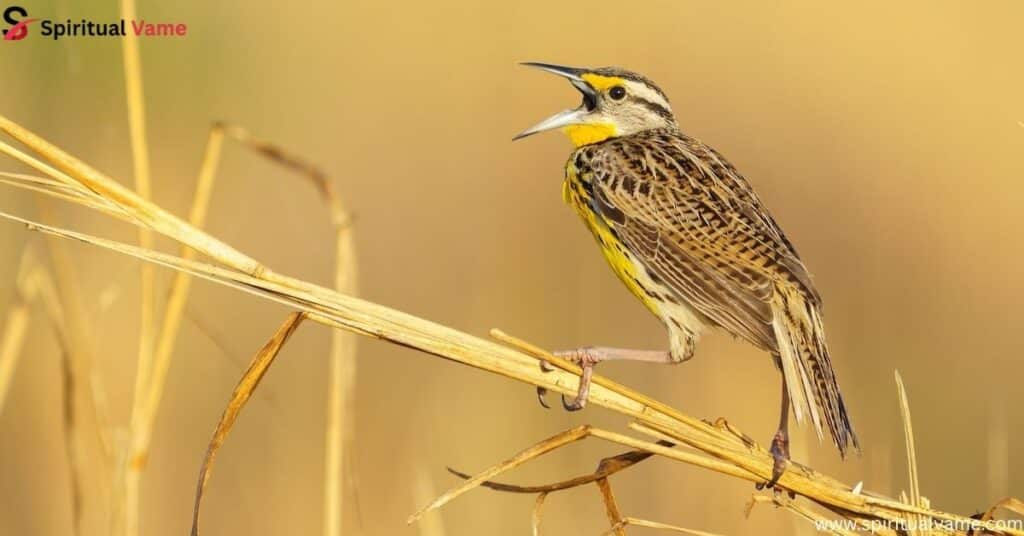
The Eastern Meadowlark is a grassland bird with a brilliant yellow belly and a black “V” across its chest. Though they look like larks, they are actually part of the blackbird family. They are most often seen perched on fence posts or walking through open fields.
These birds have a flutelike song that echoes across meadows and farmlands. Unfortunately, due to habitat loss, their numbers are declining. Conservation of prairies and native grasslands is vital to their survival in Illinois and beyond.
7. Yellow Warbler
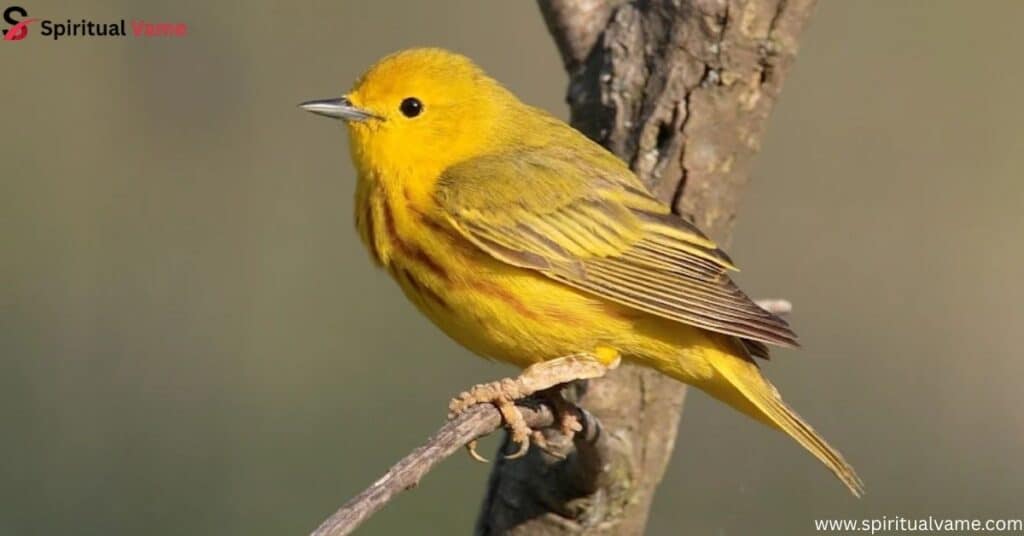
The Yellow Warbler is one of the brightest and most striking yellow birds in Illinois. Its entire body is a rich golden-yellow with slight red streaks on the chest in males. This warbler thrives in shrubby thickets and wetlands, where it forages for insects.
Yellow Warblers are highly territorial during the breeding season and are known to defend their nests fiercely, especially from brood parasitism by cowbirds. Their cheerful “sweet-sweet-sweet I’m so sweet” song makes them a favorite among birdwatchers.
8. Palm Warbler
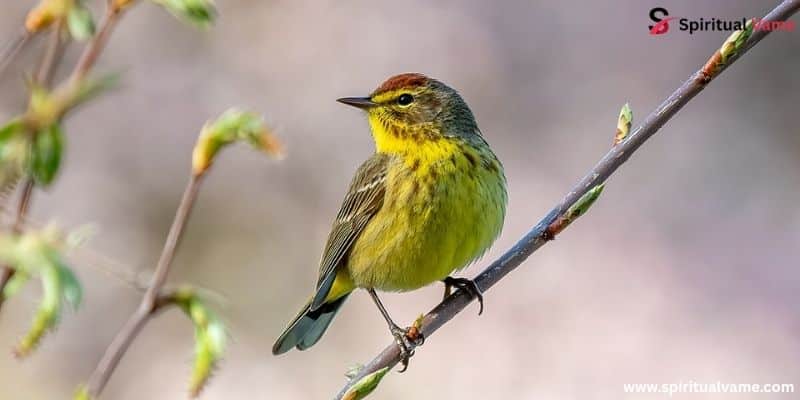
The Palm Warbler is a migrating warbler that passes through Illinois during spring and fall. It can be recognized by its constant tail-wagging and rusty cap. Though its name suggests tropical environments, Palm Warblers breed in boreal forests and migrate through the Midwest.
These warblers often forage on the ground, unlike many other warblers that stick to tree canopies. Their subtle yellow underparts and active movements make them fun to observe during migration season.
9. American Redstart Female
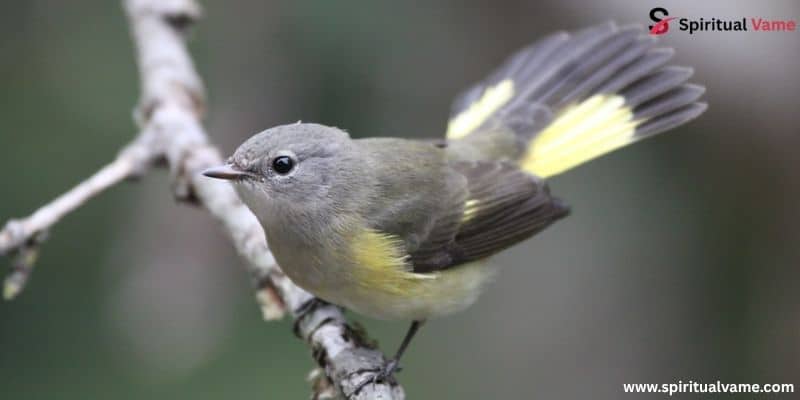
The female American Redstart is mostly yellow and gray, very different from the black and orange male. They are energetic and often fan their tails to flush out insects. You’ll usually find them flitting among trees and shrubs in search of food.
These warblers are a good example of sexual dimorphism, where males and females look very different. They are part of the insectivorous group of warblers and contribute to natural pest control in Illinois habitats.
10. Magnolia Warbler
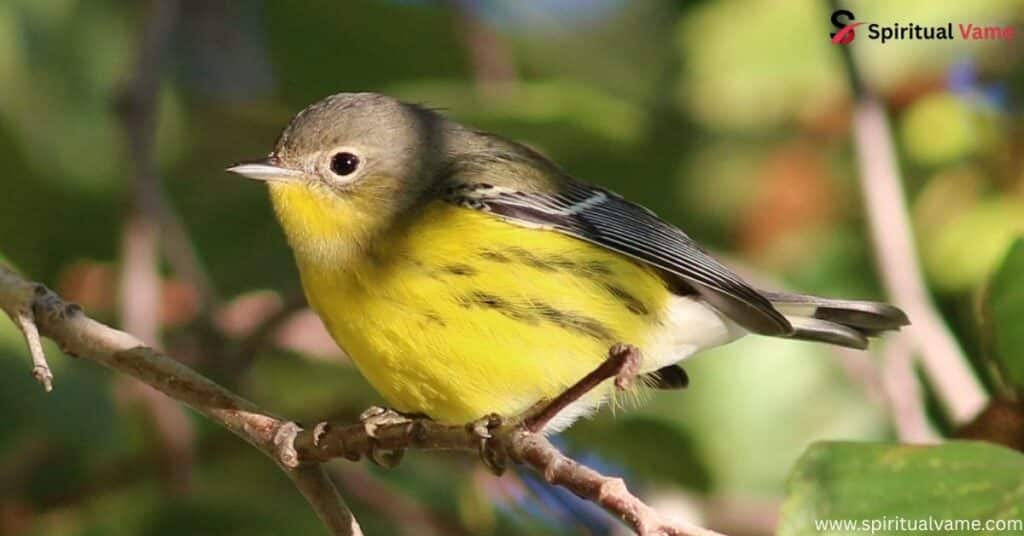
The Magnolia Warbler is a stunning migratory bird seen in Illinois primarily during spring. Males have bold black stripes across a yellow chest, while females are slightly duller. They are small and often found flitting through dense shrubs and low trees.
They get their name from being first spotted in a Magnolia tree, but in Illinois, you’re more likely to see them in forests and parks during migration. Like other warblers, they have a short stay in the state, so timing is key to spotting one.
11. Nashville Warbler
The Nashville Warbler is a tiny, yellow-bodied warbler with a gray head and white eye ring. It is most often seen during migration, although some breed in the northern parts of Illinois. These birds prefer dense shrubs and second-growth forests.
Despite their name, they are not particularly common in Nashville. They forage for insects in the underbrush and are quite active during their brief stay in Illinois in spring and fall.
12. Dickcissel
The Dickcissel resembles a small meadowlark with its yellow chest and black throat patch. These birds are found mostly in grasslands and open fields in Illinois during the summer breeding season. They are seed eaters and often seen perched on tall plants or fences.
Their buzzy “dick-dick-ciss-ciss-ciss” song gives them their name. They are an important species in Illinois prairies and serve as indicators of habitat quality for grassland birds.
13. Black-throated Green Warbler
The Black-throated Green Warbler is a vivid bird with a yellow face, greenish back, and a striking black throat on the male. Females have a less pronounced black throat but share the same lively yellow tones. These birds breed in the forests of northern Illinois and are seen more commonly during migration.
They prefer mature woodlands, especially coniferous or mixed forests. Their buzzing “zee-zee-zee-zoo-zee” song is distinctive and can help birders locate them among thick foliage. Their diet consists mainly of insects, making them a valuable part of the forest ecosystem.
14. Scarlet Tanager Female
The male Scarlet Tanager is known for his brilliant red body and black wings, but the female is a beautiful shade of olive-yellow with darker wings. These birds breed in large deciduous forests throughout Illinois and are often heard before they are seen.
Females are more secretive than males and spend much of their time hidden in the canopy. Scarlet Tanagers are migratory, spending winters in South America. Their presence in Illinois forests signals a healthy and diverse habitat, critical for many bird species.
15. Orchard Oriole Female
The Orchard Oriole Female is yellow-green and less vivid than her chestnut-colored male counterpart. These birds prefer open woodlands, orchards, and riverbanks. In Illinois, they are common during the breeding season, arriving in late spring.
They are frugivorous but also eat insects during nesting season to feed their young. Their nests are delicately woven and usually hung from slender branches. The female’s subtle colors help her stay camouflaged while incubating eggs.
16. Yellow-throated Vireo
The Yellow-throated Vireo is a bright yellow bird with olive-green on its back and white wing bars. It is most notable for its bold yellow throat and face. This bird is often found high in the trees of deciduous forests across Illinois during summer.
Its song is a slow, burry series of whistles, often described as “three-eight, three-eight.” These insectivorous birds are important predators of forest insects and are a welcome sight for birdwatchers during breeding season.
17. Wilson’s Warbler
The Wilson’s Warbler is a charming little warbler with a bright yellow body and a black cap on the male. These birds are found during migration, usually flitting through shrubby edges and forest understories. They are very active and frequently flick their tails.
Wilson’s Warblers are especially important as they reflect the migration patterns of small songbirds. Birders in Illinois can see them during both spring and fall, especially in areas like Rock Cut State Park in Rockford, Illinois, which offers excellent stopover habitat.
18. White-eyed Vireo
The White-eyed Vireo is an energetic bird with a grayish-green back and yellow flanks. Its white eye with a yellow ring gives it a sharp and piercing expression. These birds prefer dense underbrush and thickets, often near water.
They sing a mix of sharp, choppy notes, which they repeat frequently. Their secretive behavior can make them hard to spot, but their loud songs often give them away. They play a role in insect control and are active foragers during the breeding season.
19. Orange-crowned Warbler
The Orange-crowned Warbler is mostly olive-yellow with a faint orange patch on the crown, usually hidden. It’s a subtle-looking bird compared to other warblers, but it’s a frequent visitor during migration. In Illinois, they are often seen in parks and woodland edges.
They feed on insects and small spiders and are known to probe leaves and bark with their thin bills. Though not brightly marked, their soft colors and delicate movements make them a favorite among those who appreciate subtle beauty.
20. Cape May Warbler
The Cape May Warbler is a striking warbler with yellow underparts streaked with black, a chestnut cheek, and a dark crown. It’s more commonly seen during spring and fall migration and is especially fond of spruce and pine trees.
This bird is known for feeding on nectar, particularly during migration when insects are scarce. It uses a unique, coiled tongue to sip nectar, an adaptation not common among warblers. Cape May Warblers are a rare treat for Illinois birders.
21. Summer Tanager Female
The Summer Tanager Female is a soft yellow bird that contrasts sharply with the bright red male. These birds prefer oak and pine woodlands and are most active during the summer breeding season in southern and central Illinois.
They feed mostly on bees and wasps, catching them in midair and removing the stingers before eating. Their gentle “pit-ti-tuck” calls and smooth songs can be heard echoing through forested areas during the warmer months.
22. Canada Warbler
The Canada Warbler has a bright yellow belly and a necklace of black streaks across its chest, which is especially noticeable on males. These warblers pass through Illinois during migration and are often seen in shady, moist woodlands.
Despite the name, they breed in Canada and the northern U.S., but Illinois provides important stopover habitat during their long migratory journey. Their energetic movements and bold facial markings make them stand out during spring birding.
23. Prothonotary Warbler
The Prothonotary Warbler is a dazzling yellow bird with blue-gray wings and a stout body. Unlike many warblers, it nests in tree cavities near water, such as swamps and flooded forests in southern Illinois.
They are one of the few cavity-nesting warblers, often using abandoned woodpecker holes. Their presence is a good sign of healthy wetland ecosystems, and they are often monitored for conservation purposes due to habitat decline.
24. Pine Warbler
The Pine Warbler is one of the few warblers that can be found year-round in some parts of Illinois, especially in areas with abundant pine trees. It has a yellow chest, olive back, and white wing bars. These warblers are more relaxed in behavior compared to other fast-moving warblers.
They feed on insects but will also eat seeds, especially in winter. They often come to suet and seed feeders, making them one of the more approachable warblers for backyard birdwatchers. Their sweet trill is one of the earliest spring songs in pine forests.
25. Blue-winged Warbler
The Blue-winged Warbler is a striking bird with a bright yellow body and gray-blue wings. It’s commonly found in shrubby fields and young forests in southern and central Illinois. Its “bee-buzz” song is distinctive and helps with species identification in the field.
This warbler is closely related to the Golden-winged Warbler, and the two often hybridize where their ranges overlap. Conservationists monitor these interactions closely because of concerns over population declines in both species.
Conclusion
Yellow birds in Illinois are more than just pretty faces. They are vital contributors to biodiversity, and each species plays a unique role in the ecosystem — whether they’re controlling insects, spreading seeds, or simply brightening our landscapes. From the vibrant American Goldfinch to the elegant Prothonotary Warbler, Illinois is blessed with a colorful array of avian visitors and residents.
Whether you’re exploring the forests of Rock Cut State Park in Rockford, Illinois, or simply observing from your backyard with a field guide and binoculars, birdwatching can be a deeply rewarding hobby. Not only does it connect us with nature, but it also increases awareness of the need for habitat conservation in the face of threats like climate change and habitat loss.
So, the next time you hear a sweet trill or spot a golden flash in the trees, take a moment to appreciate the rich world of yellow birds in Illinois — they are treasures in feathered form.

